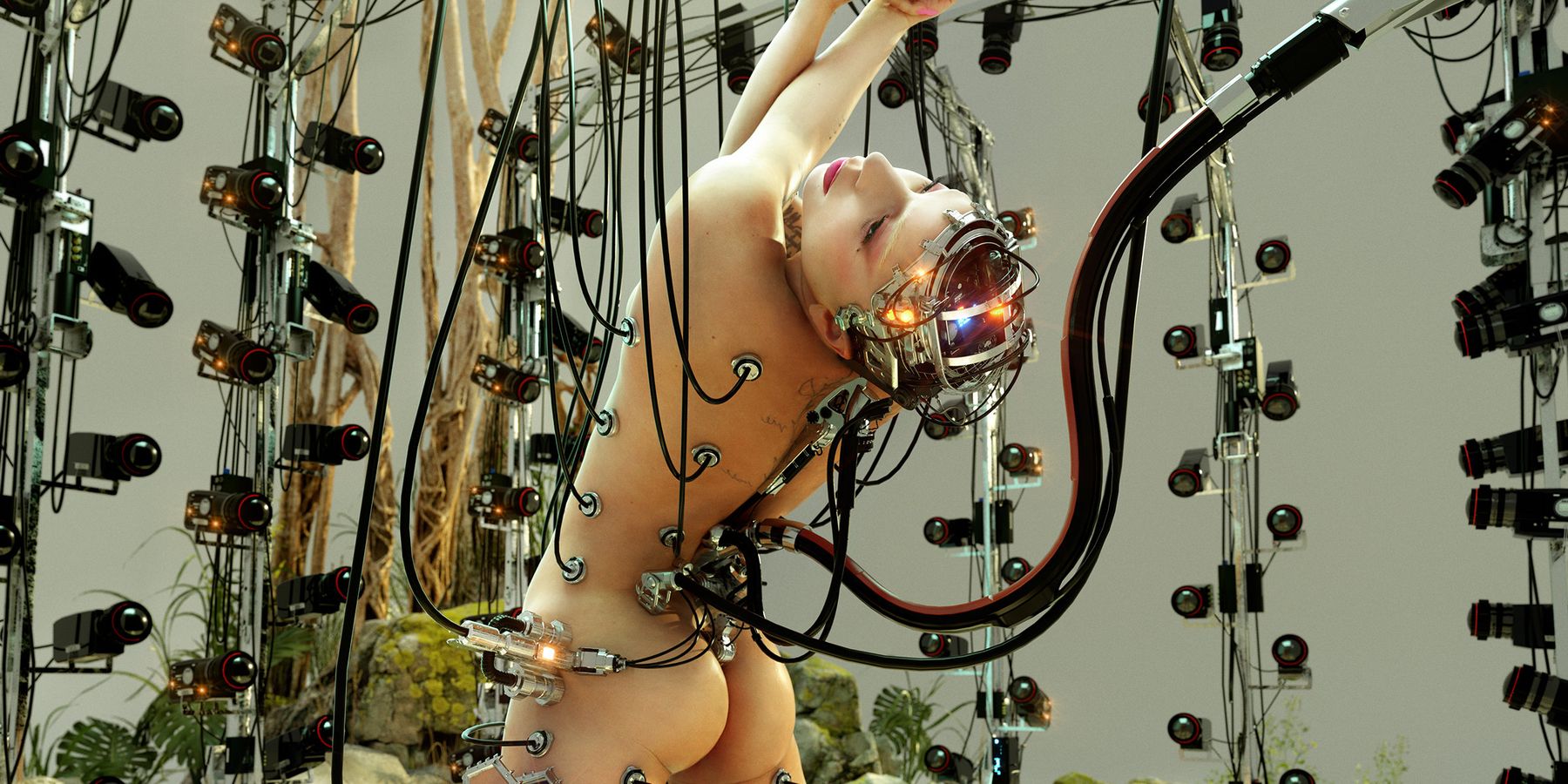
Lady Gaga: Life on Chromatica
Story by Justin Moran / Photography & Imagery by Frederik Heyman / Creative Direction by Nicola Formichetti / Styling by Sandra Amador & Tom EereboutMar 16, 2020

"I consent to being nude with everyone in this room," Lady Gaga says, before slipping off her custom Versace robe emblazoned with her name on the back in crystals. "I believe we're making art, this isn't pornography." With nothing on — not even her signature towering heels — the 5'2'' pop star walks confidently onto set for our cover shoot and positions herself inside a cage with hundreds of cameras attached to its frame. The countless lenses focus on her naked form, prepped to capture all angles of her body, as she holds one still pose and patiently waits for further instruction. "Three, two, one." Flash. Every camera goes off in unison like lightning.
The scene is immediately jarring: A global icon, whose career has been closely documented by cameras, sometimes against her will, and whose art has frequently centered on the violence of paparazzi culture, submitting herself to the same technology that's made — and challenged — her for the past 10 years. She calls for her longtime manager, Bobby Campbell, to play a song off her sixth studio album, and asks him to turn it up: "Louder, please." Amidst a flurry of wild animal noises, references to partying in "BC" and fierce house beats, Gaga warns listeners to "battle for your life" on the track, as she mouths each lyric to herself. It's the only song played all day, and she requests for it to be queued back to back.
In control of all of the cameras is Belgian artist Frederik Heyman, who needs every inch of her body 3D-scanned in order to later create a computer-generated Gaga avatar in various digitally constructed environments. This multimedia cover shoot is in conversation with the visual language being honed by Gaga and her team for her new album, Chromatica, out April 10. It's named after a world "that celebrates all things" — where, according to Gaga, "No one thing is greater than the other." On set, Gaga works from this same headspace, treating everyone in the room as a collaborator, especially when it comes to styling. She specifically rejects wearing head-to-toe designer clothing, instead opening up conversation for "a more fucked-up" fashion direction. "It doesn't need to go together, it just needs to be upsetting," she says, pointing lovingly to a pair of flame-printed panties.
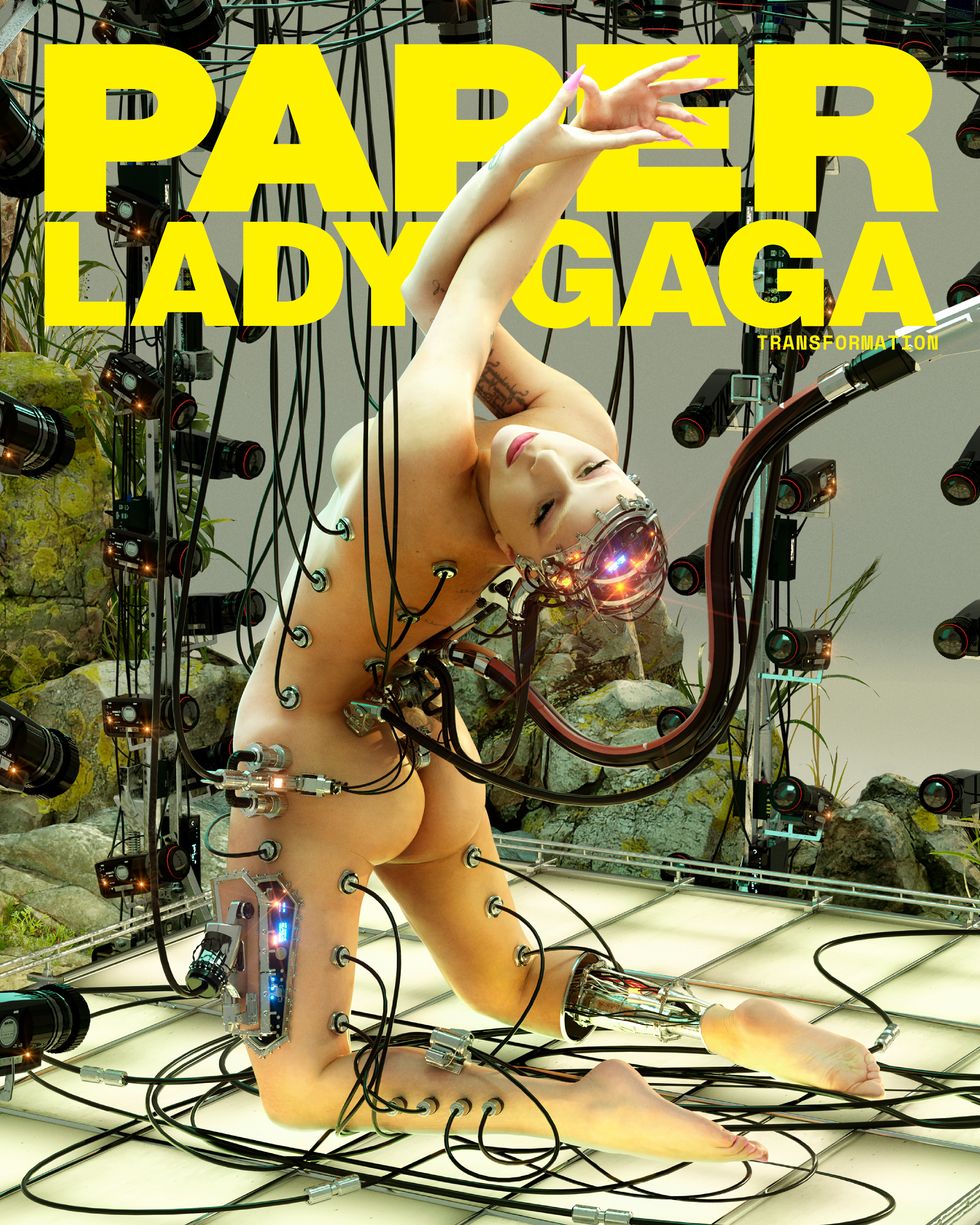
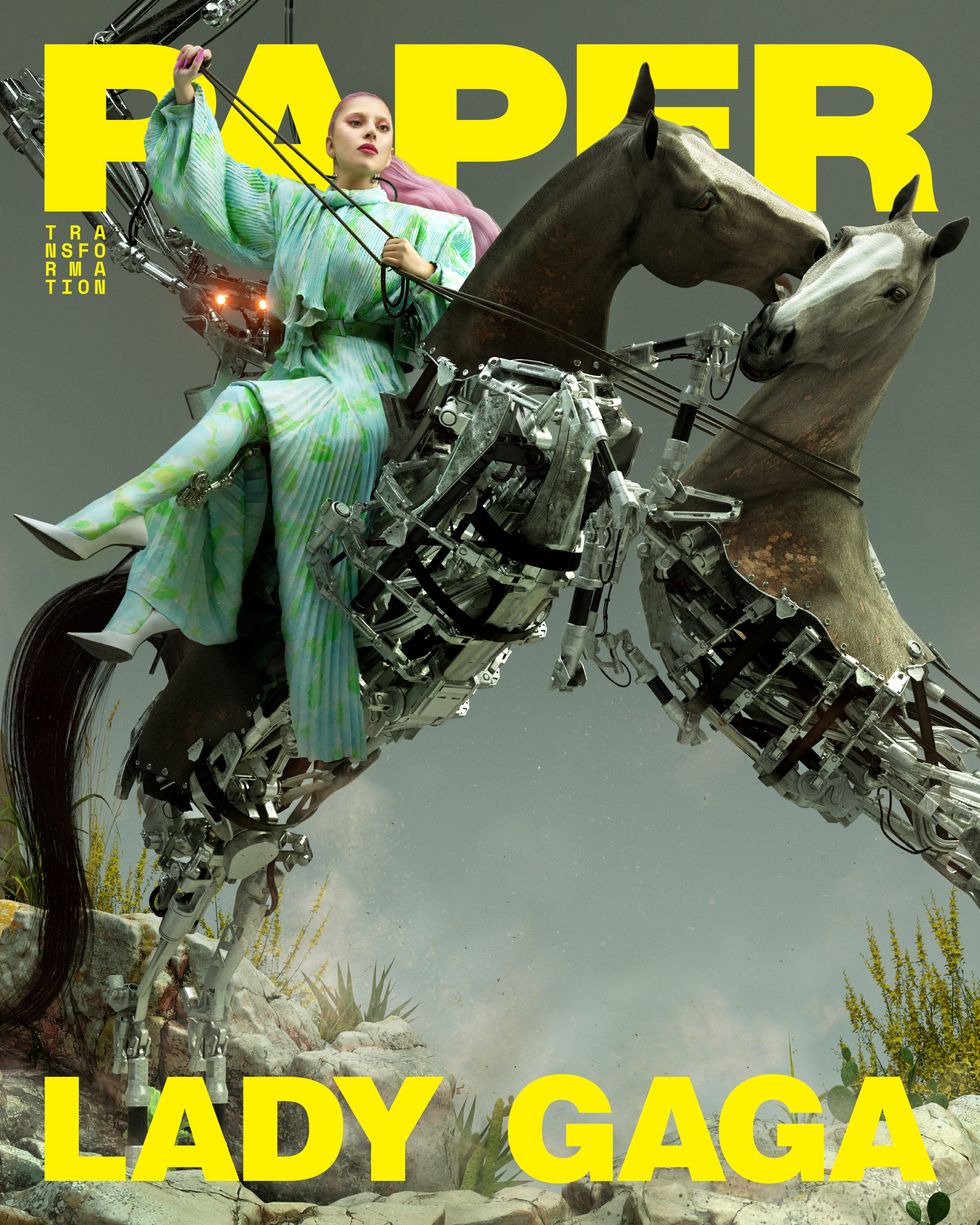
All clothing and accessories: Balenciaga
When Heyman describes his plan to depict the pop star as a contrasting half-human / half-android figure, Gaga, ever the artist in control of her nuanced brand and vision, quickly challenges the intent behind this idea. "I don't like futurism for the sake of it," she respectfully asserts more than once. Gaga is also fixated on a much deeper truth at the heart of Chromatica's ethos. "A robot puts me above people," she muses. "Do you think a robot me is better than a human me?"
WHEN WE MEET AGAIN at Gaga's Los Angeles house the next day, her hair is dyed hot pink, and she's wearing a matching magenta shirt pierced with dozens of safety pins, fishnet stockings, underwear and massive black Demonia platforms. She walks into her private at-home recording studio — whiskey in hand — and informs me that somebody else had been using the space, so she'll need a few minutes to reset her sound system. Expertly navigating an intimidating maze of knobs and plugs, Gaga preps the room to play her new, unreleased music. This is the same studio where she completed Chromatica, and, she tells me, it once belonged to experimental rock musician Frank Zappa. Gaga's been living in Zappa's former LA home while her Malibu spot is under repair for damage caused by the California fires. She hasn't been back since leaving.
"This isn't Joanne," Gaga jokes up front, previewing new material that stands in contrast to her stripped-down fifth studio album, which saw her venture into folksy Americana influences à la "Million Reasons." Gaga then cues up the first song she wrote for Chromatica: lead single "Stupid Love," a relentless, driving disco-pop tune that revels in the joyful foolishness of loving someone. "I want your stupid love," she repeats passionately on the chorus — a similar sentiment to 2009's "Bad Romance," only Gaga's outlook now is much healthier and more independent. "Nobody's gonna heal me if I don't open the door," she sings, later doubling down: "Now it's time to free me from the shame."
When Gaga plays her new music inside the studio, she blows out of her seat and dances wall to wall as if performing for an arena of thousands, only she's just a few feet from me. Even a private show from Gaga somehow feels massive. Working through the "Stupid Love" music video's choreography, she holds direct eye contact — pointing and lip-syncing — before swiftly spinning around and watching her reflection in the recording booth window. By the end of each track, she's completely out of breath. It's immediately clear that these songs are something of an antidepressant for Gaga — the lyrics and melodies have temporarily relieved her from excruciating pain and the trappings of fame, as she's previously tweeted about.
Gaga is well aware that "Stupid Love" leaked in January, long before she'd even filmed its video or planned for anyone to hear it. She jokes that when hackers typically find her material, they'll leak their favorite, which validated her decision to make the track open the Chromatica era. Many fans figured she'd rush it out, but Gaga wasn't interested in releasing anything half-baked. "There was a minute where me and my manager, Bobby, were talking, 'Do we change the single?' We'd just spent months and months developing this video and choreography. And I said, 'Nope!' You know why? Because the song, when it's mixed, mastered and finished with the visuals, and everything I have to say about it — when all those things come together at once, that will be the art piece I'm making. Not a leak."
As expected, Gaga's final "art piece" is wildly ambitious, with an iPhone-shot music video that saw 50 dancers film for two days straight in the hot, dry California desert. In it, her "Kindness Punks" — dressed in that same bubblegum-pink shade Gaga wears in her studio — rush to break up a fight between different tribes segmented by colors. Gaga presents as a warrior leader, with the Chromatica symbol on her forehead like a third eye and accessories that resemble armor, from a massively spiked belt to a full-face shield. In addition to the "Kindness Punks," of which Gaga is a member, there are the "Freedom Fighters" in blue, "Junkyard Scavengers" in black, "Government Officials" in red, "Eco Warriors" in green and "Cyber Kids" in yellow. By the end, they all ultimately find mutual peace and dance together as a full spectrum.
This experience, Gaga says, further proved her newfound appreciation for the power of nature over technology. Prior to filming, Gaga rehearsed for three days and her dancers immediately followed with five of their own. Her longtime choreographer, Richard Jackson, who's responsible for movement in everything from "Telephone" to "Applause," had the challenge of creating and teaching dances that would last the duration of "Stupid Love" without stopping. Gaga gushes, "I want you to imagine people dancing for eight to 10 hours straight. I watched them work so hard — the blood and sweat. Scrapes from dancing in the desert or getting poked in the eye from a stud that knocked them in the face. They're breathing in sand, they can't see. The conditions alone were ridiculous."
After extensive rehearsal, a drone was finally used to film the scene on-site, though it didn't have nearly the same drive as Gaga and her dancers. "The damn thing lasts three-and-a-half minutes" before dying, Gaga laughs. "I was like, 'Oh, are you tired? Was that choreography too hard for you?' And I had another epiphany: I said, 'I can't even rely on this drone to capture this shot for me. But these dancers behind me? Their bodies are killing them, they all feel like fainting. That is more powerful than anything. The human spirit is remarkable.' I told the dancers before we left for the desert, 'This might be the hardest thing you've ever done, and if it's not, I did it wrong. But you can do it, and when you look back on this time, you'll remember how strong you are.'"
WHILE RECORDING Chromatica, Gaga says she often "couldn't get off the couch" because her head-to-toe body pain was so extreme. But BloodPop®, the hit producer whom Gaga describes as the "center" of her new album, would consistently empower her to push forward and create. "He'd be like, 'Come on, let's go. We're going to make music.' And I'd be maybe crying or venting about something that was happening in my life over some pain or depression I was feeling." Together, they co-wrote songs that temporarily brought Gaga joy. "I'd start out the day so down and I'd end up dancing, looking in the mirror, practicing my moves, singing along," she says. "Every day was an enlightening experience, but it had to happen every day."
Gaga was 19 years old when she was raped repeatedly by an unnamed man she knew in the entertainment industry — an incident she openly discussed during Oprah's 2020 Vision tour. The musician developed PTSD as a result, exacerbated by her decision not to seek treatment early on. "I did not have a therapist," Gaga told Oprah in January. "I did not have a psychiatrist. I did not have a doctor help me through it. I just all of a sudden became a star and was traveling the world, going from hotel room to garage to limo to stage. And I never dealt with it." Instead, Gaga said she "used to cut" herself as a means to cope with everything that triggered her pain. "I have scars," she told Oprah.
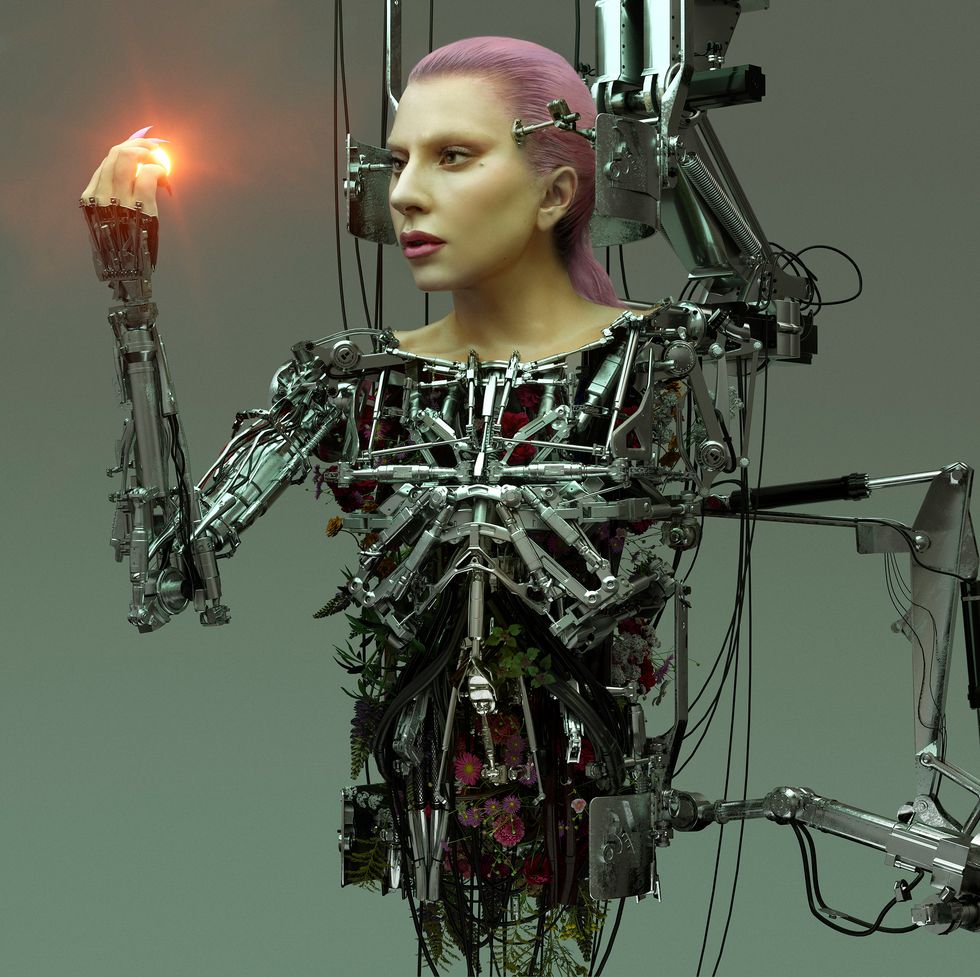
After years of having avoided processing her rape, Gaga's body finally said "enough" in 2013. Little Monsters will recall a video capturing the exact moment Gaga's hip broke while she was performing "Scheiße" in Montreal during her Born This Way tour. She let out a bloodcurdling shrill, slowly lowered herself to the ground and somehow still mustered the strength to complete the song's difficult choreography. All remaining tour dates were then cancelled, while Gaga privately recovered.
In 2017, Gaga was diagnosed with a condition called fibromyalgia, which leaves her with chronic full-body pain as a trauma response, recreating the illness she says she felt after being raped. "The debate around fibromyalgia, we could have it for hours," Gaga says, matter-of-factly. "Some people believe in it, some people don't. Essentially it's neuropathic pain: My brain gets stressed, my body hurts." For the past few years, Gaga has been rightfully angry at having limited solutions for living comfortably with the pain. "[I'm] angry at my body, angry at my condition, angry that when I'm stressed my body hurts," she says.
She describes something called "radical acceptance" as a means for getting her through this dark period, "where you have to 'radically accept' that you're not going to feel well every day, maybe a little bit. Some days are way worse, some days aren't. But you know what I can do? I can go, 'Well, my hands work; my arms work; my legs work, even though they are sore; my back works; my brain works; my heart works; I'm taking breaths, my lungs work.' You can just be grateful for what you can do."
Chromatica can be seen as a reflection of this radical acceptance; it's an album Gaga describes as "dancing through her pain." Featuring explosive anthems that brim with euphoric synth-pop climaxes (way bigger than The Fame), its lyrics nevertheless reflect Gaga's more somber, personal experiences. "It's a smack across the face throughout the album," Gaga says of its celebratory sound. "We don't stop being that happy. You will hear the pain in my voice and in some of the lyrics, but it always celebrates."
Still, Gaga acknowledges the idiocy of unwavering happiness (and the fact that pop, and the mainstream music market at large, is often designed to sell that lie). "Give me a break, [happiness is] not that simple," Gaga says. "I have clinical depression. There's something going on in my brain where the dopamine and serotonin are not firing the same way, and I can't get there. If someone says, 'Come on, just be happy,' I'm like, 'You fucking be happy.'"
With Chromatica, however, Gaga wants to put forth an ideology that suggests it's possible to feel joy even at the same time as you're experiencing sorrow — like putting a happiness filter on life. "I will do whatever it takes to make the world dance and smile," she says. "I want to put out a record that forces people to rejoice even in their saddest moments. And by the way, I'm not standing over here with a flag going, 'I'm all healed, everything's perfect.' It's not; it's a fight all the time. I still work on myself constantly. I have bad days, I have good days. Yeah, I live in Chromatica, it took a minute to get here, but that doesn't mean I don't remember what happened. So if you're in pain and listening to this music, just know that I know what it's like to be in pain. And I know what it's like to also not let it ruin your life."
OF COURSE, you could say Gaga's music has been "making the world dance and smile" since day one. Often, the exuberance she makes people feel is rooted in her embrace of inclusivity and equality — steady themes throughout Gaga's career, from her early opposition to the US military's discriminatory "don't ask, don't tell" law (repealed in 2010) to her LGBTQ epic, Born This Way, released in 2011. "No matter gay, straight or bi, lesbian, transgender life," she sings on the title track, which ultimately inspired the creation of her Born This Way Foundation "for a kinder, braver world." But another recurring motif has always been a fixation on the future. In the Nick Knight-directed music video for Born This Way's title track, Gaga births a new, "infinite" race that "bears no prejudice, no judgment, but boundless freedom." As the character "Mother Monster," she's soaked in extraterrestrial pregnancy slime, living on G.O.A.T. (a "Government-Owned Alien Territory" in space), and describing the "mitosis of the future" in relation to her fantasy anti-hate militia.
Nearly a decade later, Gaga now says "we're living in the future," which is why Chromatica — as a concept — feels like the result of every seed initially planted on that intergalactic G.O.A.T. In her studio, Gaga clarifies her updated stance on futurism, and the reasons she wanted to question it on set. "I've been obsessed with the future for so long, going, What's next?" she says. "And then I turned back and looked at my life. I unpacked all the things I've learned that have helped me and that have hurt me, and that taught me infinitely more. Now, [the past] informs my work. It's like I was blocked because I was so obsessed with what was next, what was coming, what does it mean to go forward, that I didn't realize I was already in the future. And where we are, where we stand in the present, is powerful."
Today, Gaga says she lives in Chromatica, which, unlike G.O.A.T., isn't a fictional location at all. "It's a perspective," Gaga corrects, pointing to her heart. "It's right here. I might sound silly, but I'm on it right now — I'm not on another planet. If you see and listen to Chromatica, and you want to live there, too, you're invited. But I do want to be clear that it's not a fantasy." Gaga earnestly explains that it's as if she "deleted Earth" and "replaced it with Chromatica" in her mind, making this abstract, arguably absurd process seem realistic. Admittedly, I want to be in Chromatica with Gaga, too. Maybe I am?
She came up with the name alongside BloodPop®, who previously worked with Gaga on Joanne, as well as with artists like Justin Bieber, Grimes and Madonna, among others. Together, they felt Chromatica represented, in its simplest form, "a spectrum of people" that "all shared the same perspective" and always believed in "kindness over war." But Gaga wanted its ethos to dig even deeper. "It became not just about saying all people are included (all colors, all races, all ethnicities, all gender identities, all sexual identities, all religious identities)," she says. "It's saying there are more colors and more kinds than we could possibly fathom. We're all so different and that's the perspective."
But Gaga reiterates that Chromatica is not "this imaginary fairy-tale happy land where everything's perfect," and understands the inevitability of darkness co-existing with the light. "In order to understand love, you have to understand that there's hate," she says, in another parallel to G.O.A.T. and her "Born This Way" video when Mother Monster questions, "How can I protect something so good without evil?" Much as Gaga continues to reconcile these opposing forces on Chromatica, she also needed to wrestle with this duality in her own life and face her preexisting trauma head-on, which she says is the "bravest step you can take as a human."
Referencing close friends who have struggled with finding healthy ways to work through their own pain, Gaga explains what made her realize just how difficult it is to honestly process your past. "I can't tell you who, but I've met people who have said to me, while sucking down bottles and bottles of wine and doing drugs, 'I will never do what you did. I will never take care of my heart and my emotions the way that you have.' And it really made me think about what a step it was for me in my life to decide to get healthy mentally."
Gaga continues, "I want my legacy to be the most beautiful diary that I ever could've made. And diaries are meant to be true. I think when we start lying to ourselves in our diaries, we start to create secrets within ourselves that don't help us. I like to look myself squarely in the eye now."
WHEN GAGA LOOKS BACK on the evolution of her music career, she sees a clear development of influences. She starts by referencing her rape as a life-altering experience that set the tone for how she created art as a young adult. Not long after, she "went on tours and became very traumatized by the pace of fame and everything I had to do — what was required of me physically and mentally changed the way I wrote. Relationships, family, friends, isolation, traveling all the time, no sleep." Through it all — the inevitable extreme highs and lows of a superstar who's been built up and torn down by the public — Gaga says she doesn't regret anything she's ever made.
The topic of ARTPOP comes up, specifically Gaga's contentious 2019 tweet, "I don't remember ARTPOP," which sent fans into an absolute frenzy in defense of her underrated, critically slammed 2013 effort. As it turns out, Gaga does, in fact, recall her sometimes controversial third album. "I think it's funny that I'm not allowed to have a sense of humor," she says. "The internet is essentially a big joke, but if I tell one everyone freaks out. I don't regret my art, and I wouldn't suggest anyone do." Though ARTPOP couldn't possibly compare to the colossal success of Gaga's first two albums, it's certainly her most experimental to date. (Justice for "Sexxx Dreams," the hit single that never was.) "I look back at ARTPOP and look at music today, and I see a lot of things that were very..." Gaga pauses to find the right word. "Futuristic. Or they were ahead of their time, and I'm okay with saying that."
There was a period where Gaga says she was more "introspective" and therefore wanted to make music for herself, starting with ARTPOP and then with Joanne. Both albums were polarizing, vastly different projects for longtime fans to initially digest, but they froze an honest moment in time for an artist being pulled in two directions: by the immense pressures of fame, as well as her own need for self-fulfillment. "Joanne was exactly what I wanted to do," Gaga affirms. "The way I wanted to do it, the way I wanted it to sound, and so was ARTPOP — everything about it. Every album has been exactly what I wanted to make at that time. It's just there was a period where I think I forgot about where I was, and maybe that's why it's been so important for me with Chromatica to reestablish where I am for myself. So that here can mean something very powerful."
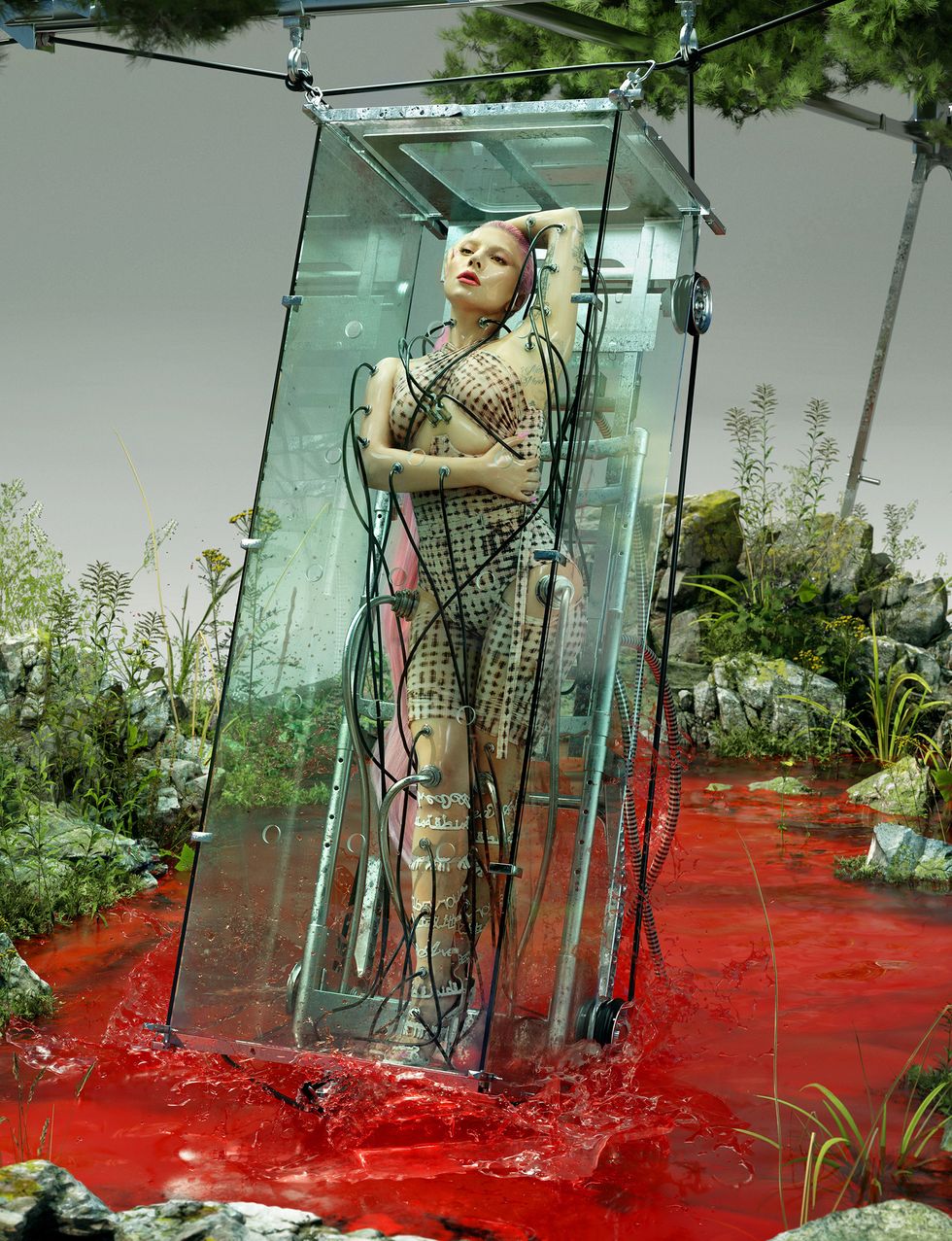
Clothing: Charlotte Knowles, Shoes: Area
While creating Chromatica, Gaga says she reconnected with the way she believes music moves through her, like a messenger for some higher spirit. She believes in God, having grown up Catholic, but says God is "too big" for her to fully understand. According to Gaga, ideas for songs on Chromatica came to her by "opening the portal to the other realm and listening to God," which is why it all sounds so positive. "That's what the other realm was telling me to create," she says. "I might, to some people, sound like I have a perspective on life that's eccentric, but I actually don't think that my talent belongs to me." When Gaga was younger, she remembers hearing melodies in her head and "running to the piano." The portal has been with Gaga her entire life, only she forgot for a brief moment to listen.
One such message led Gaga to collaborate with a fellow female pop star, who has similarly experienced immense trauma while in the public eye. Their song together is a monster of a dance tune, but its message is about submitting yourself to devastation ("It's coming down on me, water like misery") — a flawless dance floor crier as a "celebration of all the tears," Gaga describes. "I sat with her and we talked about our lives. It's two women having a conversation about how to keep going and how to be grateful for what you do." Without being prompted, Gaga raises the inevitable criticism that celebrities face when they say "it's hard to be famous." She knows that "75% of the world rolls their eyes," but Gaga counters: "Yeah, you can be in a mansion, but you can still be six feet under in one."
Elsewhere in Chromatica, Gaga explores topics like her antipsychotic medication ("My biggest enemy is me, pop a 911") and the undeniable force of femininity ("I'm not nothing without a steady hand"), the latter of which acknowledges both her own strength as well as that of the community who has "cheer[ed] her on" and helped her "become a woman." Specifically, she calls out trans women and gay men for helping her cope with PTSD and move past any spirals associated with reliving her pain. "In 2020, what does it mean to be a free woman?" Gaga questions, prompting a song that answers this question and sees her challenging the need to be with a man — or anyone at all — in order to survive. "Can I feel free on my own? Do I need to be loved in order to feel like I've conquered it all?" Speaking to the track's origin, Gaga says, "It came from thinking on some days I was going to die. I was like, 'I'm going to die soon, so I better say something important.' Now I listen to it and know that I'm going to live."
IF CHROMATICA is a mindset where "kindness rules all," created as a gift "for the world," Gaga says it was crucial for the collaborative process to also mirror these values. Gaga flags the difficulty of consolidating more than two years of music-making with tons of different producers into one interview, and instead proposes that she create an Excel spreadsheet for me detailing exactly who worked on what. Above all, Gaga wants to talk at length about BloodPop®, her other "nucleus" on Chromatica. "We combined," she says of working with him on this project. "I'm overwhelmed by the amount of love he had to offer me. I could not have made this album without him. He was the world's most incredible alarm when the ambulance was coming."
All of the musicians involved — BURNS, Axwell, Rami Yacoub, Benjamin Rice, Tchami and more — would work on Chromatica as an equal group effort, which is rare considering how so many producers "can get very territorial" based on Gaga's previous experience. "It was a very fluid process with no ego," she says. "Every single thing you hear on Chromatica was passed around and things would get removed, changed or altered. Everyone here heard it or touched it." That's why songs like "Stupid Love" sound notably soulful and complex. "It's easy to go into a computer and find a cool loop, but the producers I work with don't work this way. When they're inspired, they embroider things."
From start to finish, Chromatica is firmly rooted in classic house, with crisp, clubby dance breaks that all sound like they're competing with each other to be the biggest on the tracklist. Sonically, it's perhaps Gaga's most focused, consistent album to date, with all these producer contributions laddering up to the same fearless electronic tapestry, weaving in unruly breakbeat outros, emotional power-pop melodies that send a dopamine rush through the brain and tons of slick, shiny synths. You can weep to these songs just as much as you can sweat to them, and Gaga seems to be encouraging both at once.
Tensions can easily rise in-studio, but Gaga proudly attests that she experienced the opposite while recording Chromatica. "I think the only day me and BloodPop® ever had a fight was when I was trying to learn a jazz tune because I was going to see Tony [Bennett] really soon. He was like, 'We have to finish this!' and I was singing a Cole Porter record in the corner," she laughs. "And that wasn't even really a fight." Rather, BloodPop® was more focused on bringing people together through this process. "It was like some really talented, wonderful men all joined arms with BloodPop® in front of all of them and he was like, 'Do you remember how much you've changed the world? Do you know how much you have to offer people?' He reminded me that every day, no matter how hard it was."
And on Chromatica, what Gaga offers is openness, honesty and an affirmation of the human spirit — hers and the rest of the world's. "The human spirit is more fucking powerful than anything," she says. "I think Chromatica is the most honest thing I could've ever created, and I'll never forget making this record. It's been one of the most special and hard times in my life." As if to drive home her points at the end of our meeting, Gaga picks up a giant, green crystal on the coffee table, surrounded by speakers, microphones and mixers. "Do you know crystals have been around for billions of years?" she asks, smiling. "The past is incredible. Look what we've done without technology. Look how we've survived without it. Look how we've kept going." Certainly no drone could say the same.
Photography and imagery: Frederik Heyman
Creative direction: Nicola Formichetti
Production: Brandon Zagha
Stylist: Sandra Amador and Tom Eerebout
Hair: Frederic Aspiras
Makeup: Sarah Tanno
Nails: Miho Okawara
CG and 3D post production: Mathematic
Scanning studio: Human Engine
Line producer for Frederik Heyman: Roxane Lemaire